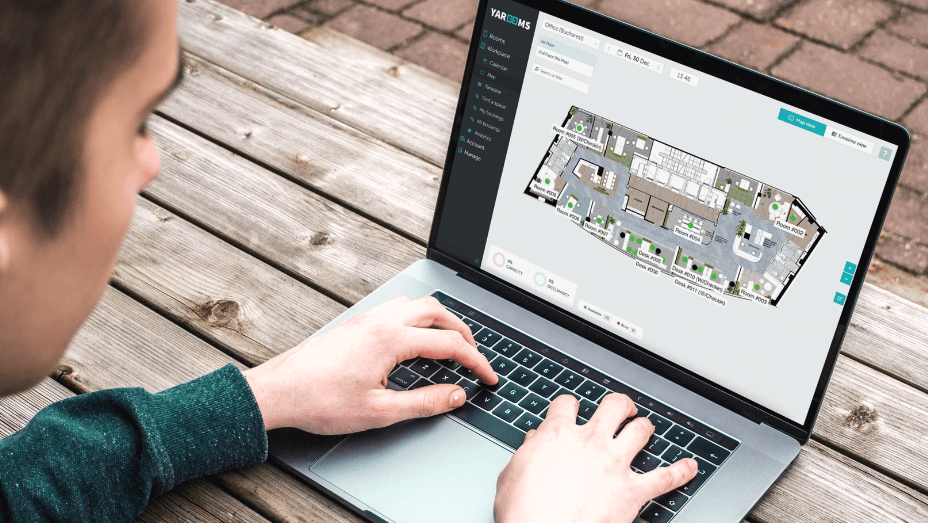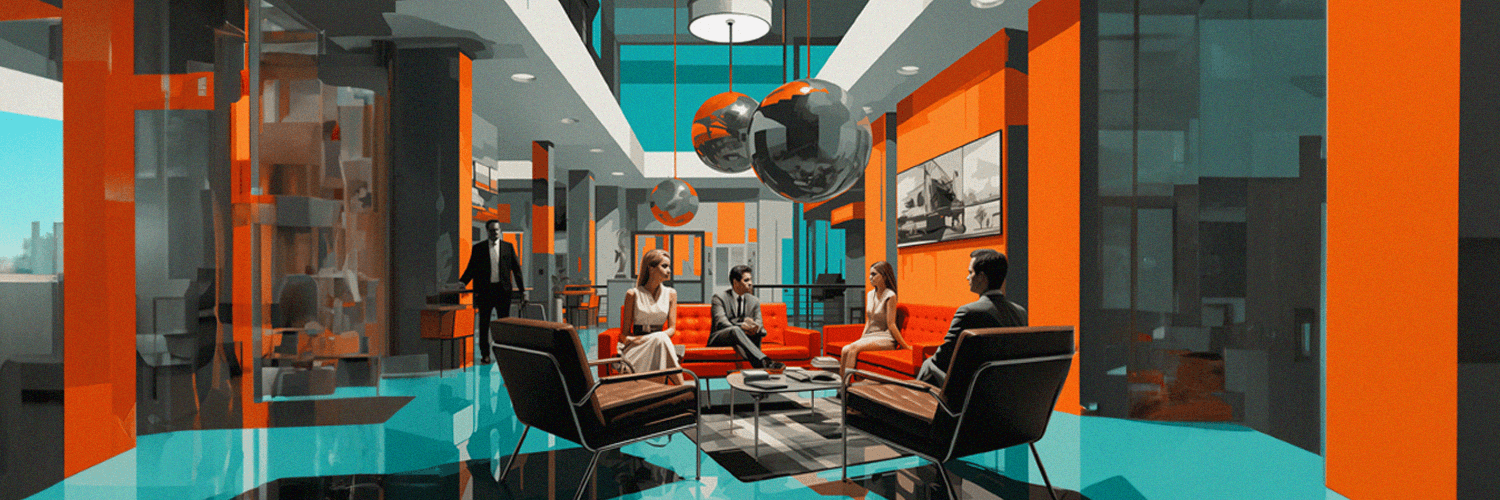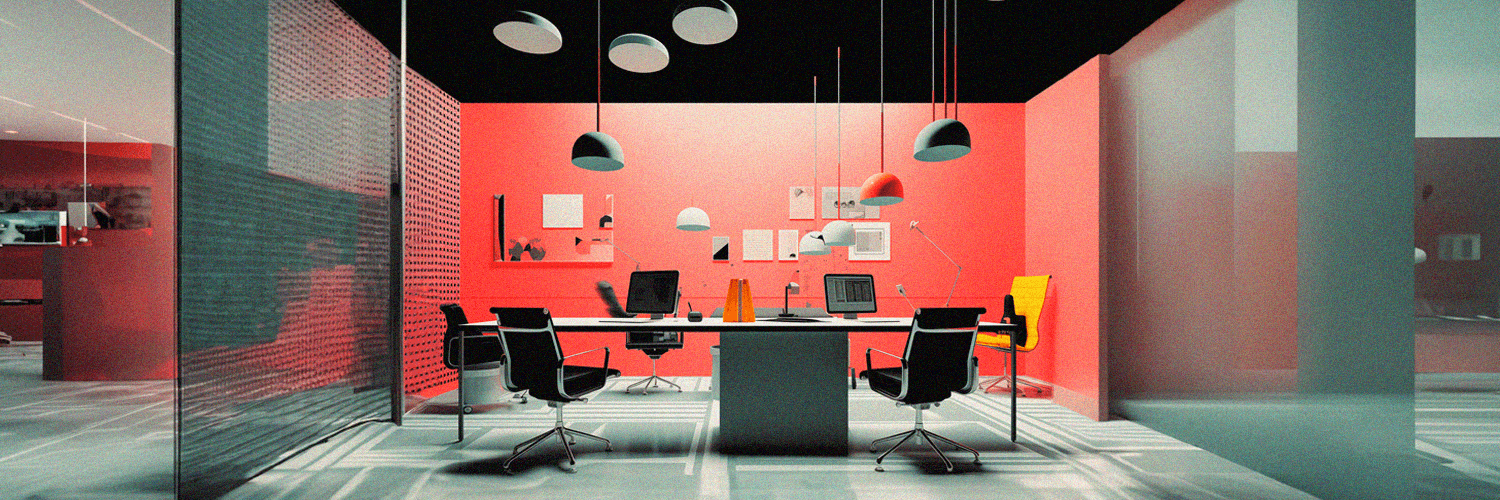Managing an office environment doesn’t need to be difficult. Especially with the right office space software at hand.
One that provides you with the right data – the core of any successful facility management strategy – and even further gives you access to valuable insights into office space utilization.
Insights that you can then use to streamline your otherwise overwhelming operations as a facility manager.
And to design a workplace that encourages collaboration and innovation, that boosts engagement and productivity. By identifying underutilized spaces and repurposing them.
In this article, we’ll learn exactly how an office space management solution can help you streamline your operations, what are the key benefits of using one and which essential features to look for when considering a work space management software.
TL;DR:
- Office space software simplifies facility management by providing real-time data and valuable insights.
- It helps streamline operations and optimize office space utilization.
- Desk and room booking tools prevent double bookings and provide insights into space utilization.
- The software allows for reconfiguring office space to meet employees' changing needs.
- It helps identify unused spaces and popular areas to optimize office layout and save on real estate costs.
- Administrative tasks can be managed more efficiently with a centralized software solution.
- Office space software enhances the employee experience by providing autonomy and predictability.
- It contributes to creating a safe work environment by preventing overcrowding and scheduling conflicts.
- Essential features of office space software include space booking, support for different space types, office layout maps, configurable properties, capacity management, mobile app access, utilization analytics, and integrations.
- Pricing factors for office space software include customization options, support, integrations, scalability, and track record.
- Using office space software empowers facility managers to adopt a proactive approach and optimize the workplace to meet employees' needs and drive overall success.
What Is Office Space Software?
It’s an office space management software (or office space utilization software) that simplifies and streamlines the way you manage your facility.
Take it as your “toolbox” of office space planning tools at hand, that helps you better:
- Plan: create strategic space plans based on actual employee data and office space usage (real-time) data
- Optimize: streamline adds, moves, downsizes, design improvements, and reconfigure your space office with more confidence
- Manage: streamline all your space management operations as a facility manager, from maintenance to handling all the incoming requests to overseeing facility functionality
With accurate and real-time data at hand – employee data, office space utilization data, available resources data, budget-related data – AND with valuable insights into how the space is being utilized, you can do your job:
- more efficiently
- more effectively
- more confidently

Why Do You Need an Office Space Software Solution?
We’ve already briefly touched on some of the key benefits of using a space management software solution as a facility manager.
But now let’s delve deeper into HOW exactly spaces software can help you manage your workspace more efficiently.
And more effectively, too.
Streamline Desk and Room Booking
With desk management software (and a room booking tool, too) integrated into your office space management software, you’ll prevent scenarios like:
- Double bookings of conference rooms, meeting rooms, desks, and other resources
- Inaccurate estimation of certain office spaces’ capacities
… from happening.
It grants you seamless resource booking:
- You get real-time and accurate insight into office space utilization
- You get valuable insight into how many employees are working on-site vs those working remotely at any given time of day/week
- You get to be (way) more agile when it comes to updating your work schedule planning
And all these benefits, deriving from a streamlined desk and room booking process, will reflect on the overall employee work experience.
That’s the ultimate “barometer” of success for all your efforts and initiatives as a facility manager, after all.
Reconfigure Office Space to Suit Your Needs
Managing office space effectively goes beyond shift schedule planning, overseeing facility functionality, and… handling office space cleaning needs.
It’s about creating a productive and engaging work environment.
This calls for a constant reconfiguration of the workspace to suit the changing and growing needs of the employees actually using it.
This is where office space solutions come to streamline your efforts.
You have insights into occupancy rates, employee behavior, and workspace utilization that you can use to reconfigure the workspace until it fits the employees’ current needs.
“Employee needs” that become way clearer to you with such valuable, real-time workplace analytics available. In real-time.
Optimize Office Space Usage
When using an office space solution, through the data it provides you with, you can see, clearly:
- Which are those unused, “dead” spaces in your workspace
- What are those areas in your office space and those work arrangements that are most popular among the employees
- How people are actually interacting with and within the space you’re managing
And once you know which are the hotspots in the office and the “dead” zones, too, you already have a clear(er) vision of what an office that boosts productivity, engagement, and collaboration should look like.
Then you can make well-informed decisions on how to optimize the office layout. And improve space utilization.
Save On Real Estate Costs
Workplace management software helps you gain more clarity on how employees are actually using the workspace.
And on how they’re not using it…
In other words, space management software helps you identify ways to cut down on expenses on real estate.
For instance, it can reveal to you that, in a hybrid work environment, open office areas and meeting rooms are much less used compared to office desks.
Or that only… let’s say… 40% of the office space is occupied on a regular basis. And only some key areas are highly frequented for work or collaboration. And for knowledge sharing.
In short, it teaches you about your workspace. So you can then:
- See, clearly, how much the office space size can be reduced and how you can get the most out of your space
- Make informed decisions on reducing essential building functions (e.g. HAC)
- Cut down on maintenance expenses
Spend Less Time on Administrative Tasks
Planning and monitoring schedules, managing contracts, managing all types of incoming requests, optimizing the floor plan, managing the budget, allocating the needed resources…
You sure wear a whole lot of hats as a facility manager!
And yet, managing an office space doesn’t have to be THIS challenging and overwhelming.
Because space management software helps you oversee all these tasks from a single access point. In a single view.
This way, you:
- save the time you’d waste by going back and forth between operations and joggling with several, separate and overly specialized tools you’re using to carry out your different tasks
- streamline projects that otherwise may seem discouragingly intricate thanks to the floor plan view, request management system, scenario tool that an office space management software provides you with
- grow more effective at allocating resources: you see clearly what you have and what the employees need to be successful so you can better organize your internal and external resources
Enhance Employee Experience
Autonomy is crucial to the employee experience. Employees want full autonomy and control over where they’ll be seated in the office space.
They also expect predictability and self-guided flexibility.
The level of predictivity that they get when they can secure meeting rooms in advance, themselves. When it’s in their power to prevent overbooking and… chaos in the office space.
When they can have their schedules clearly delineated.
And autonomy, predictability, and self-guided flexibility are precisely what office space planning software offers them. And how it improves the employee experience.
Keep All of Your Spaces Safe
A workplace management software helps you, the office space manager, create a safe(r) work environment, too.
How exactly?
Just think about the safety challenges that all of the following scenarios would pose:
- Overcrowded conference and meeting rooms
- Double booking the same office desks
- Having too many employees working on the same shift
- Scheduling conflicts, where the same person/team is supposed to be in 2 (or more) office space rooms at the same time.
- Or at very close intervals of time, forcing them to rush in from one room to another…
A space management software – incorporating both room and desk booking tools – helps you prevent all these risky scenarios.
You have all the data at insights that you need – floor plans updated in real-time, data on the available desks, and occupancy data reports – to plan better (and safer) how the space will be used.

8 Essential Features of Office Space Software
At this point you might start to ask yourself:“What are the key features to look for in an office space management software?”
Here are the 8 must-have ones:
Space (Desks, Meeting Rooms) Booking
A desk booking tool incorporated into your workplace management software gives your employees the level of flexibility they’re expecting.
While offering you a clear insight into how the space is being used so you can make the most of it:
-
You can easily track how the employees interact with the space office
-
Employees can easily book a free desk (plus space amenities and other space types, like parking space), on the spot, from anywhere.
Whereas a meeting room booking tool incorporated in the same workspace management software comes to simplify and streamline room reservations.
And especially when there are several companies sharing the same office building – n interview rooms, n meeting rooms, n conference rooms to book across – things tend to get quite… challenging.
That’s why meeting room booking software becomes an essential part of a facility manager’s toolkit:
- Everyone can see, in real-time, when specific rooms are available and book them, right away, regardless of their tech savviness
- The one shared space calendar is easy to access by everyone in the team and very straightforward
- As a facility manager, you get easy access to 3 essential metrics to monitor for ensuring secure room management: capacity limits, time buffers, and people flow control
Support for Different Office Space Types
Your space software of choice should enable you to define office space types that share the same booking characteristics – working days, time buffer, recurring booking, incognito booking, etc. – check-in (simple or QR) and capacity characteristics.
Meeting rooms vs parking lots, vs. office deks vs conference rooms vs… meeting rooms.
Furthermore, your office space software should go beyond that and enable you to set up different “reservation/check-in rules” for different spaces within the same office space.
For instance, within the same parking space, you can have bicycle and electric parking lots.
Office Space Layout Map
Make sure your work space management software comes equipped with the right office layout tools, too.
A space map view will allow both you and the employees to:
- visualize real-time and future availability
- find office spaces/office desks with specific characteristics
- get a real-time overview of the percentage of floor occupancy and allowed floor capacity, number of non-bookable spaces, number of available and already booking spaces
Configurable Office Space Properties
Also, make sure the space management software you select enables you to assign configurable properties to the office spaces you book.
For instance, you should be able to select, right at the time of the booking, different conference room facilities you might need, or between standing and sitting desks, single and dual monitors, etc.

Office Capacity Management
Another essential feature to look for in your workplace management software.
With office capacity management tools incorporated into your office space solution making the most of your managed space becomes so much simpler:
- You know exactly what your office space capacity is
- You can then configure it to suit your employees' current needs and improve your space’s UX
For instance, you can then design activity-based spaces in your office, encouraging social interaction between employees and fostering a sense of belonging.
Office Space Mobile App
You want yourself and the employees to be able to plan your days at the office.
To simply log into your office space planning software and book rooms and resources, extend room bookings, change floors, and check yourself in on the go.
At any time. Wherever you might be.
In short, you’ll want your work office space management tool to come with a mobile app version, too.
One that has a good user interface and is conveniently simple to use, too.
Office Space Utilization Analytics
What makes this feature in your future work space management software essential?
The answer is simple. With real-time access to office utilization metrics like:
- Real-time occupancy
- Capacity
- Average office space utilization
- Number of bookings
- Number of no-shows
- Amount of bookings per user
- General happiness level of your employees
… at hand, you can make data-based decisions when it comes to optimizing and best maximizing your office spaces to meet your employees' current needs.
Which might be:
- To work in an office environment that allows them to be efficient and productive
- To collaborate, innovate and… bond with their teammates while in the workspace and recreate those rich interactions they’re missing remotely
Integrations
You’ll want your future office space software to plug seamlessly into your entire ecosystem of workplace apps.
So you can have them share information with each other, to optimize and streamline workflows, and deliver the best employee experience.
With your office space management tool integrated with your workplace technology stack – Google Meet, Google Calendar, Zoom Meetings, Microsoft Teams, etc. – you:
- Spare your employees (and yourself) of much of the manual work
- Automate workflows
- Reduce costs (e.g. Lower your IT team's overhead costs)
Factors That Influence Office Space Software Pricing
Let’s say you now have your short list of space management software “candidates”.
And they all feature (at least) the 8 essential features previously mentioned.
Yet, things become challenging, once again, as their prices vary.
How do you navigate this sea of options? What factors are responsible for an office space planning software’s price, after all?
Here are the key ones:
- The number of customization options available
- The platform’s focused on the workplace experience as a whole (vs a basic space management software)
- Level of support offered: onboarding training, ongoing support, responsiveness to your specific needs
- The number of integrations available
- Dedicated Account Manager
- Meeting room and lobby display
- API access
- Data isolation
- Track record of success
- Scalability: an office space software’s price can go up and down depending on the number of users and the customer’s growing needs
- Work-related carbon emission monitoring features
Needless to add that the price of a business workplace management solution will differ from that of an enterprise one. For large companies, with more complex needs.
Office Space Software and Successful Facility Management Go Hand-In-Hand
Data is crucial for the success of your facility management strategy.
You need data to:
- support your case in front of the board of executives for driving key organizational decisions
- streamline all your facility operations
- plan, design, and constantly optimize THAT efficient workplace that scales with the employees’ changing needs
And clear, accurate, real-time data and valuable insights is what good office space management software provides you with.
So you can go and grow from having a reactive approach to managing your office space(s) to adopting a proactive one.
Where you identify opportunities and find ways to improve the workplace so that it:
- meets employees’ current needs (not the other way around)
- helps them to be successful in their work
- sets the company, as a whole, up for success
This being said, are you ready to get the most out of what an office space management tool has to offer and set your own facility management strategy up for success?


.png)









